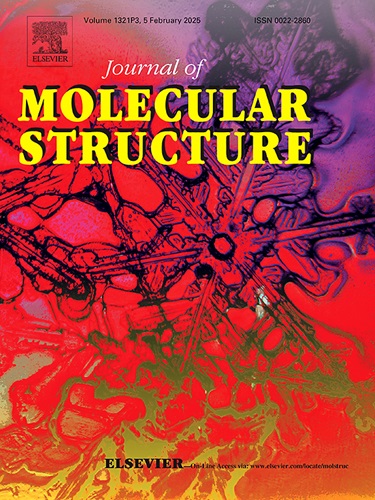综述了三氰甲烷阴离子过渡金属配合物的合成、表征、单晶x射线衍射及应用
IF 4
2区 化学
Q2 CHEMISTRY, PHYSICAL
引用次数: 0
摘要
本文综述了未发现的N/O和N给体希夫碱(SBs)与三氰甲烷阴离子(TCM)的过渡金属配合物[C(CN)3]-,重点介绍了它们的设计、合成、结构表征和应用。由于中药配合物与金属离子(Mn+)具有不同的桥接吸引力和众多的应用,越来越多的科学关注强调了这一综述的重要性。本文只考虑具有x射线晶体结构的金属配合物。x射线晶体结构由剑桥晶体数据中心(CCDC)和剑桥结构数据库(CSD)获得。元素(CHN),常规光谱,SCXRD(单晶x射线衍射),TGA, PXRD,荧光和磁矩表征了金属配合物。中药复合物由于其迷人的x射线晶体结构和源自中药桥接倾向的超分子化学而受到越来越多的研究兴趣。因此,本文着重介绍了该材料在光致发光/荧光、热磁矩和变温磁矩等多维领域的潜在应用。综述还寻找了尚未开发的应用研究领域,包括复合物的生物学方面,如抗菌,真菌,抗真菌光动力治疗(APDT)和细胞毒性,以及备受瞩目的基于dft的研究。同时,综述了文献中揭示的x射线晶体学新超分子特征。本文将启发下一代研究人员在调整间隔剂在配位化学中的积极作用后,揭示中药复合物的广泛化学性质。本文章由计算机程序翻译,如有差异,请以英文原文为准。
A comprehensive review of synthesis, characterization, single-crystal X-ray diffraction, and applications of transition metal complexes with tricyanomethane anions
This review article showcases unrevealed N/O and N-donor Schiff bases (SBs) transition metal complexes with tricyanomethane anions (TCM), [C(CN)3]-, primarily focuses on their design, synthetic update, structural characterization, and applications. The increasing scientific focus on TCM complexes, owing to their diverse bridging attraction with metal ions (Mn+) and numerous applications, underscores the importance of this review. Only those metal complexes with available X-ray crystal structures are considered for this review article. X-ray crystal structures were obtained from the Cambridge Crystallographic Data Centre (CCDC) and the Cambridge Structural Database (CSD). Elemental (CHN), conventional spectroscopy, SCXRD (single-crystal X-ray diffraction), TGA, PXRD, Fluorescence, and magnetic moment characterize the metal complexes. TCM complexes are growing in research interest due to their fascinating X-ray crystal structure and supramolecular chemistry originating from TCM's bridging propensity. Therefore, the review emphasizes the potential uses in multidimensional areas, including Photoluminescence/Fluorescence, thermal, and temperature variable magnetic moment. The review also searches for less explored research areas of applications covering complexes' biological aspects such as antibacterial, fungal, antifungal photodynamic therapy (APDT) and cytotoxicity, as well as high-profile DFT-based investigation. Meanwhile, the review examines the X-ray crystallographic in-depth novel supramolecular features unveiled in the literature. This article will inspire next-generation researchers to divulge the TCM complex's broad chemistry after tuning the spacer's active role in coordination chemistry.
求助全文
通过发布文献求助,成功后即可免费获取论文全文。
去求助
来源期刊

Journal of Molecular Structure
化学-物理化学
CiteScore
7.10
自引率
15.80%
发文量
2384
审稿时长
45 days
期刊介绍:
The Journal of Molecular Structure is dedicated to the publication of full-length articles and review papers, providing important new structural information on all types of chemical species including:
• Stable and unstable molecules in all types of environments (vapour, molecular beam, liquid, solution, liquid crystal, solid state, matrix-isolated, surface-absorbed etc.)
• Chemical intermediates
• Molecules in excited states
• Biological molecules
• Polymers.
The methods used may include any combination of spectroscopic and non-spectroscopic techniques, for example:
• Infrared spectroscopy (mid, far, near)
• Raman spectroscopy and non-linear Raman methods (CARS, etc.)
• Electronic absorption spectroscopy
• Optical rotatory dispersion and circular dichroism
• Fluorescence and phosphorescence techniques
• Electron spectroscopies (PES, XPS), EXAFS, etc.
• Microwave spectroscopy
• Electron diffraction
• NMR and ESR spectroscopies
• Mössbauer spectroscopy
• X-ray crystallography
• Charge Density Analyses
• Computational Studies (supplementing experimental methods)
We encourage publications combining theoretical and experimental approaches. The structural insights gained by the studies should be correlated with the properties, activity and/ or reactivity of the molecule under investigation and the relevance of this molecule and its implications should be discussed.
 求助内容:
求助内容: 应助结果提醒方式:
应助结果提醒方式:


